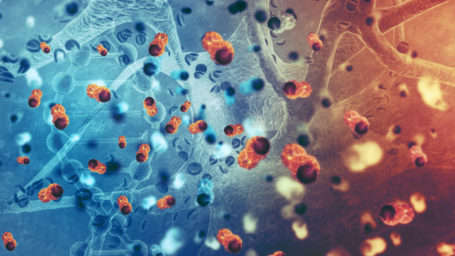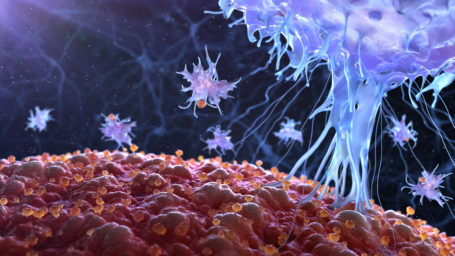Program Leaders



Mission Statement
The mission of the Cancer Biology Program is to provide basic discoveries that lead to new approaches and identify novel targets for treating and preventing cancer.
Specific Aims: The overarching goal of the Cancer Biology Program is to improve understanding of the biochemical, molecular and cellular mechanisms underlying tumor development, progression and metastasis. To achieve this goal, research in the Cancer Biology Program has the following aims:
- Aim 1: Delineate molecular mechanisms that drive the development and progression of cancer.
- Aim 2: Define contributions of stromal-tumor cell interaction in determining tumor behavior and patient response to therapy.
- Aim 3: Understand the mechanisms that suppress tumor immune responses and potential approaches to overcome immune suppression.
Primary Areas of Research

Cancer Initiation and Malignancy
Determine the cellular processes that contribute to the malignant transformation, growth, and metastasis of cells.

Tumor Microenvironment
Determine the cellular processes that contribute to the malignant transformation, growth, and metastasis of cells.

Tumor Immune Response
Understand interactions between cancer cells and stromal components of tumors that affect cancer growth and metastasis and how they can be targeted to inhibit growth.
Features Publications:
- Wolfe AR, Cui T, Baie S, et al. Nutrient scavenging-fueled growth in pancreatic cancer depends on caveolae-mediated endocytosis under nutrient-deprived conditions. Sci Adv. 2024;10(9):eadj3551. doi:10.1126/sciadv.adj3551
- Dai L, Fan J, Qin Z. Development of human endogenous retrovirus type K- related treatments for human diseases. J Med Virol. 2024;96(3):e29532. doi:10.1002/jmv.29532
- Chen J, Lin Z, Song J, et al. Echinomycin as a promising therapeutic agent against KSHV-related malignancies. J Hematol Oncol. 2023;16(1):48. Published 2023 May 4. doi:10.1186/s13045-023-01441-5
- Yeager C, Carter G, Gohara DW, et al. Enteroviral 2C protein is an RNA-stimulated ATPase and uses a two-step mechanism for binding to RNA and ATP. Nucleic Acids Res. 2022;50(20):11775-11798. doi:10.1093/nar/gkac1054
- Gao J, Gao Z, Putnam AA, et al. G-quadruplex DNA inhibits unwinding activity but promotes liquid-liquid phase separation by the DEAD-box helicase Ded1p. Chem Commun (Camb). 2021;57(60):7445-7448. doi:10.1039/d1cc01479j
- Edwards AD, Marecki JC, Byrd AK, Gao J, Raney KD. G-Quadruplex loops regulate PARP-1 enzymatic activation. Nucleic Acids Res. 2021;49(1):416-431. doi:10.1093/nar/gkaa1172
- Sabol HM, Ferrari AJ, Adhikari M, et al. Targeting Notch Inhibitors to the Myeloma Bone Marrow Niche Decreases Tumor Growth and Bone Destruction without Gut Toxicity. Cancer Res. 2021;81(19):5102-5114. doi:10.1158/0008-5472.CAN-21-0524
- Cheng Y, Sun F, Alapat DV, et al. High NEK2 expression in myeloid progenitors suppresses T cell immunity in multiple myeloma. Cell Rep Med. 2023;4(10):101214. doi:10.1016/j.xcrm.2023.101214
- Sabol HM, Ashby C, Adhikari M, et al. A NOTCH3-CXCL12-driven myeloma-tumor niche signaling axis promotes chemoresistance in multiple myeloma. Haematologica. Published online February 22, 2024. doi:10.3324/haematol.2023.284443
- Sun F, Cheng Y, Chen JR, et al. BCMA- and CST6-specific CAR T cells lyse multiple myeloma cells and suppress murine osteolytic lesions. J Clin Invest. 2024;134(1):e171396. Published 2024 Jan 2. doi:10.1172/JCI171396
- Sun F, Cheng Y, Wanchai V, et al. Bispecific BCMA/CD24 CAR-T cells control multiple myeloma growth. Nat Commun. 2024;15(1):615. Published 2024 Jan 19. doi:10.1038/s41467-024-44873-4
Meeting Time and Location
The Cancer Biology Program meets monthly on the 4th Tuesday at 4:00pm in the Betsy Blass Conference Room on the 10th floor of the Cancer Institute.
